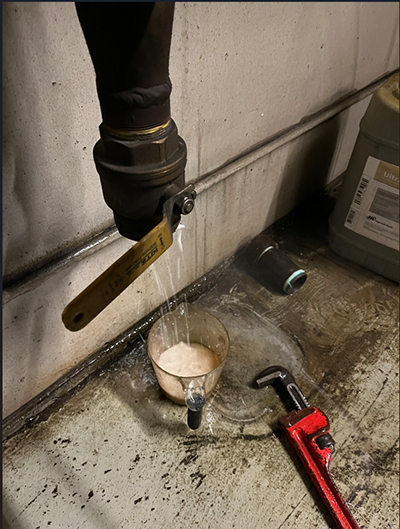
It’s always frustrating to find water in a compressed air system, and especially so in locations where the air is supposed to be dry. During a recent compressed air audit, a survey of the piping found that poor dewpoints were being experienced in the system. Investigation found that significant amounts of free water mixed with compressor lubricant had collected in low spots in the system, even on the dry side of the system where the moisture levels should be nowhere near saturation. Dealing with this problem requires a mixture of good design, timely maintenance, and continual monitoring.
When designing a compressed air system, we should always expect there will be times where the air dryer system will fail to operate correctly or when someone forgets to turn on the air dryer. Always design the compressed air piping system so that there will be a natural flow of water sloping downstream to a final drainage point with an automatic drain. Never allow installation of low spots in piping where water could collect without drainage. Always install down drops connected from the top of piping so that free water will not flow to the bottom of the connection point at the final end use.
When maintaining a compressed air system, we should ensure that we frequently check critical drainage points at the compressor water separator, at the bottom of storage receivers, on the refrigerated air dryers, and on filters. Check manual drains on any suspected low points to ensure that installed automatic drains are functioning. If water has formed on the dry side of the system, then check the operation of air dryers and the compressor cooling system. Overheating of the input air to air dryers is one of the most common problems leading to a wet system.
And always monitor your compressed air system for correct dewpoint. Probes for this purpose are very affordable and typically much less expensive than the damage caused by water contamination forming and collecting in your piping system. Free water picks up rust and scale, mixes with compressor lubricant, and can form an ugly sticky mess that can cause expensive tools and machines to fail, or worse, contaminate the end product.
Filed Under: Components Oil Coolers, Compressed Air Technologies, Pneumatic Tips, Technologies